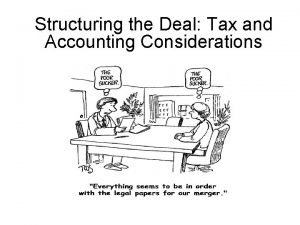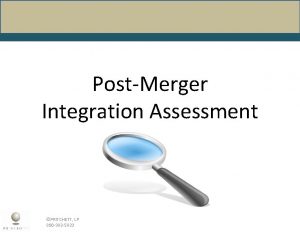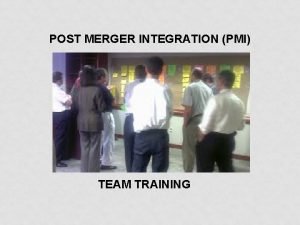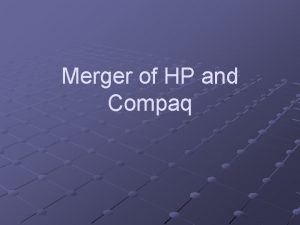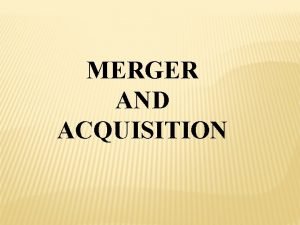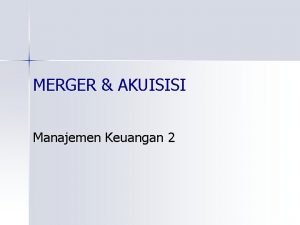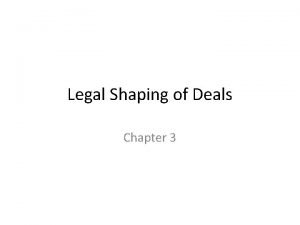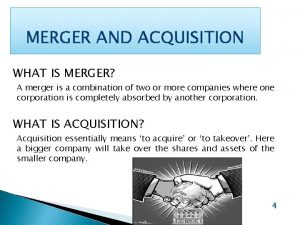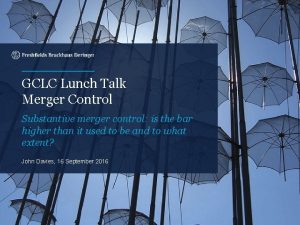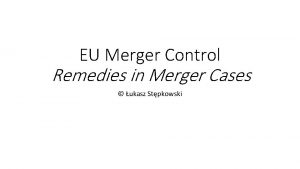Merger Control The Concept of a Community Dimension











- Slides: 11

Merger Control : The Concept of a Community Dimension © Łukasz Stępkowski

• The existence of a concentration, in itself, is not sufficient for the rules of European Union law on mergers, in particular for the Merger Regulation, to apply • In addition, where there is a concentration as provided by Article 3 of the Merger Regulation, that concentration principally has to have a „Community dimension” • Unless there is an express exception under the Merger Regulation, a concentration must fulfil the criteria for having a Community dimension • The exceptions relate to situations where, in the absence of a Community dimension, there is a certain transnational effect on the market(s) which justifies Commission’s involvement

• The Merger Regulation sets basic criteria for there to be a Community dimension for a concentration • Article 1 EUMR: 1. Without prejudice to Article 4(5) and Article 22, this Regulation shall apply to all concentrations with a Community dimension as defined in this Article. • 2. A concentration has a Community dimension where: • (a) the combined aggregate worldwide turnover of all the undertakings concerned is more than EUR 5000 million; and • (b) the aggregate Community-wide turnover of each of at least two of the undertakings concerned is more than EUR 250 million, • unless each of the undertakings concerned achieves more than two-thirds of its aggregate Community-wide turnover within one and the same Member State. • 3. A concentration that does not meet the thresholds laid down in paragraph 2 has a Community dimension where: • (a) the combined aggregate worldwide turnover of all the undertakings concerned is more than EUR 2500 million; • (b) in each of at least three Member States, the combined aggregate turnover of all the undertakings concerned is more than EUR 100 million; • (c) in each of at least three Member States included for the purpose of point (b), the aggregate turnover of each of at least two of the undertakings concerned is more than EUR 25 million; and • (d) the aggregate Community-wide turnover of each of at least two of the undertakings concerned is more than EUR 100 million, • unless each of the undertakings concerned achieves more than two-thirds of its aggregate Community-wide turnover within one and the same Member State. • 4. On the basis of statistical data that may be regularly provided by the Member States, the Commission shall report to the Council on the operation of the thresholds and criteria set out in paragraphs 2 and 3 by 1 July 2009 and may present proposals pursuant to paragraph 5. • 5. Following the report referred to in paragraph 4 and on a proposal from the Commission, the Council, acting by a qualified majority, may revise thresholds and criteria mentioned in paragraph 3.

• It follows from Article 1 EUMR that there are two „tests” and a special provision for the requirement of a Community dimension to be fulfilled, and there are certain requirements for it to be inapplicable • The tests, in themselves, are quantitative and based on turnover • a test under 1(2) EUMR is met, or • a test under 1(3) EUMR (less restrictive) is met, or • Article 4(5) applies, which results in a Community dimension being deemed to exist, or • Article 22 EUMR applies to a concentration, which omits the need for a Community dimension (but the Commission may examine it) • In addition, where there is a „ 2/3 requirement” in regard to a concentration, i. e. each of the undertakings concerned achieves more than two-thirds of its aggregate Community-wide turnover within one and the same Member State, a concentration does not have a Community dimension, and the Commission is therefore not required to examine it

• Turnover is supposed to be calculated pursuant to Article 5 EUMR • 5(1) and (2) EUMR: • 1. Aggregate turnover within the meaning of this Regulation shall comprise the amounts derived by the undertakings concerned in the preceding financial year from the sale of products and the provision of services falling within the undertakings' ordinary activities after deduction of sales rebates and of value added tax and other taxes directly related to turnover. The aggregate turnover of an undertaking concerned shall not include the sale of products or the provision of services between any of the undertakings referred to in paragraph 4. • Turnover, in the Community or in a Member State, shall comprise products sold and services provided to undertakings or consumers, in the Community or in that Member State as the case may be. • 2. By way of derogation from paragraph 1, where the concentration consists of the acquisition of parts, whether or not constituted as legal entities, of one or more undertakings, only the turnover relating to the parts which are the subject of the concentration shall be taken into account with regard to the seller or sellers. • However, two or more transactions within the meaning of the first subparagraph which take place within a two-year period between the same persons or undertakings shall be treated as one and the same concentration arising on the date of the last transaction.

• There is a notion of „linked” undertakings under 5(4) EUMR, in that in certain cases turnover has to be calculated in aggregate for certain undertakings, and that turnover between certain undertakings is excluded • 4. Without prejudice to paragraph 2, the aggregate turnover of an undertaking concerned within the meaning of this Regulation shall be calculated by adding together the respective turnovers of the following: • (a) the undertaking concerned; • (b) those undertakings in which the undertaking concerned, directly or indirectly: • (i) owns more than half the capital or business assets, or • (ii) has the power to exercise more than half the voting rights, or • (iii) has the power to appoint more than half the members of the supervisory board, the administrative board or bodies legally representing the undertakings, or • (iv) has the right to manage the undertakings' affairs; • (c) those undertakings which have in the undertaking concerned the rights or powers listed in (b); • (d) those undertakings in which an undertaking as referred to in (c) has the rights or powers listed in (b); • (e) those undertakings in which two or more undertakings as referred to in (a) to (d) jointly have the rights or powers listed in (b). • 5. Where undertakings concerned by the concentration jointly have the rights or powers listed in paragraph 4(b), in calculating the aggregate turnover of the undertakings concerned for the purposes of this Regulation: • (a) no account shall be taken of the turnover resulting from the sale of products or the provision of services between the joint undertaking and each of the undertakings concerned or any other undertaking connected with any one of them, as set out in paragraph 4(b) to (e); • (b) account shall be taken of the turnover resulting from the sale of products and the provision of services between the joint undertaking and any third undertakings. This turnover shall be apportioned equally amongst the undertakings concerned.

• • • • At times, other criterion is used instead of turnover 5(3) EUMR: 3. In place of turnover the following shall be used: (a) for credit institutions and other financial institutions, the sum of the following income items as defined in Council Directive 86/635/EEC(7), after deduction of value added tax and other taxes directly related to those items, where appropriate: (i) interest income and similar income; (ii) income from securities: - income from shares and other variable yield securities, - income from participating interests, - income from shares in affiliated undertakings; (iii) commissions receivable; (iv) net profit on financial operations; (v) other operating income. The turnover of a credit or financial institution in the Community or in a Member State shall comprise the income items, as defined above, which are received by the branch or division of that institution established in the Community or in the Member State in question, as the case may be; (b) for insurance undertakings, the value of gross premiums written which shall comprise all amounts received and receivable in respect of insurance contracts issued by or on behalf of the insurance undertakings, including also outgoing reinsurance premiums, and after deduction of taxes and parafiscal contributions or levies charged by reference to the amounts of individual premiums or the total volume of premiums; as regards Article 1(2)(b) and (3)(b), (c) and (d) and the final part of Article 1(2) and (3), gross premiums received from Community residents and from residents of one Member State respectively shall be taken into account.

• Special cases: 4(5) EUMR • 5. With regard to a concentration as defined in Article 3 which does not have a Community dimension within the meaning of Article 1 and which is capable of being reviewed under the national competition laws of at least three Member States, the persons or undertakings referred to in paragraph 2 may, before any notification to the competent authorities, inform the Commission by means of a reasoned submission that the concentration should be examined by the Commission. • The Commission shall transmit this submission to all Member States without delay. • Any Member State competent to examine the concentration under its national competition law may, within 15 working days of receiving the reasoned submission, express its disagreement as regards the request to refer the case. • Where at least one such Member State has expressed its disagreement in accordance with the third subparagraph within the period of 15 working days, the case shall not be referred. The Commission shall, without delay, inform all Member States and the persons or undertakings concerned of any such expression of disagreement. • Where no Member State has expressed its disagreement in accordance with the third subparagraph within the period of 15 working days, the concentration shall be deemed to have a Community dimension and shall be notified to the Commission in accordance with paragraphs 1 and 2. In such situations, no Member State shall apply its national competition law to the concentration.

• Special cases: 22 EUMR: Referral to the Commission • 1. One or more Member States may request the Commission to examine any concentration as defined in Article 3 that does not have a Community dimension within the meaning of Article 1 but affects trade between Member States and threatens to significantly affect competition within the territory of the Member State or States making the request. • Such a request shall be made at most within 15 working days of the date on which the concentration was notified, or if no notification is required, otherwise made known to the Member State concerned. • 2. The Commission shall inform the competent authorities of the Member States and the undertakings concerned of any request received pursuant to paragraph 1 without delay. • Any other Member State shall have the right to join the initial request within a period of 15 working days of being informed by the Commission of the initial request. • All national time limits relating to the concentration shall be suspended until, in accordance with the procedure set out in this Article, it has been decided where the concentration shall be examined. As soon as a Member State has informed the Commission and the undertakings concerned that it does not wish to join the request, the suspension of its national time limits shall end. • 3. The Commission may, at the latest 10 working days after the expiry of the period set in paragraph 2, decide to examine, the concentration where it considers that it affects trade between Member States and threatens to significantly affect competition within the territory of the Member State or States making the request. If the Commission does not take a decision within this period, it shall be deemed to have adopted a decision to examine the concentration in accordance with the request. • The Commission shall inform all Member States and the undertakings concerned of its decision. It may request the submission of a notification pursuant to Article 4. • The Member State or States having made the request shall no longer apply their national legislation on competition to the concentration. • 4. Article 2, Article 4(2) to (3), Articles 5, 6, and 8 to 21 shall apply where the Commission examines a concentration pursuant to paragraph 3. Article 7 shall apply to the extent that the concentration has not been implemented on the date on which the Commission informs the undertakings concerned that a request has been made. • Where a notification pursuant to Article 4 is not required, the period set in Article 10(1) within which proceedings may be initiated shall begin on the working day following that on which the Commission informs the undertakings concerned that it has decided to examine the concentration pursuant to paragraph 3. • 5. The Commission may inform one or several Member States that it considers a concentration fulfils the criteria in paragraph 1. In such cases, the Commission may invite that Member State or those Member States to make a request pursuant to paragraph 1.

• Case solving : check whethere is a Community dimension to the concentration below • Undertakings A, from Poland, B, from Sweden, and C, from the Czech Republic, wish to merge their Legal departaments into one undertaking, D. Their departaments are functionally separate, but do not have separate legal personalities. They make up for half of A, B and C’s turnover, and concern themselves with a market distinct from other areas where A, B and C are active. • The general aggregate worldwide turnover of A, B and C is 6000 milion EUR, split evenly. • The general Community-wide turnover of A, B and C is 3000 million EUR, split evenly. • A, B and C are active in Germany, France and the UK, where they receive 600 million EUR of revenue, split evenly. The rest of their respective Community turnover is gained in their Member State of origin. • Is there a Community dimension?

• Thank you for your attention
 Why did singapore merge with malaysia
Why did singapore merge with malaysia Pin-pen merger map
Pin-pen merger map Adam doyle nhs
Adam doyle nhs Reverse triangular merger
Reverse triangular merger Post merger integration assessment
Post merger integration assessment Post merger integration training
Post merger integration training Example of vertical mergers
Example of vertical mergers Hp bought compaq
Hp bought compaq Concentric merger example in india
Concentric merger example in india Latar belakang penggabungan usaha
Latar belakang penggabungan usaha What is merger and consolidation
What is merger and consolidation Reverse triangular merger
Reverse triangular merger



